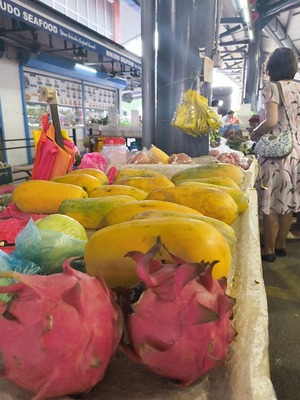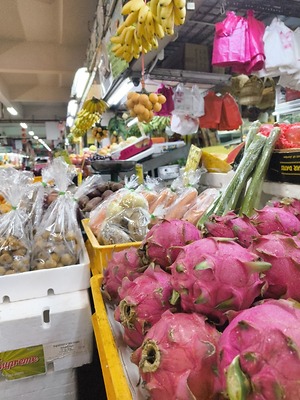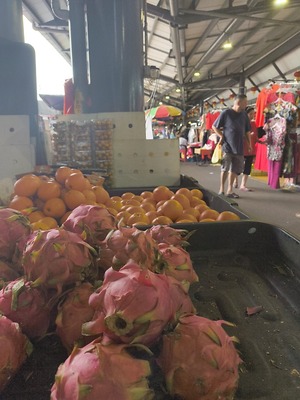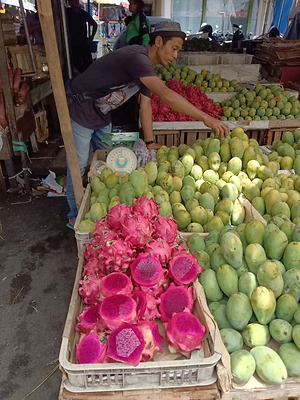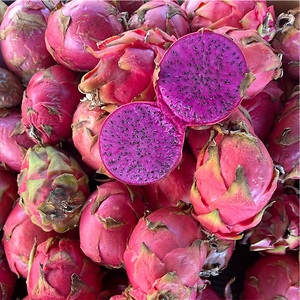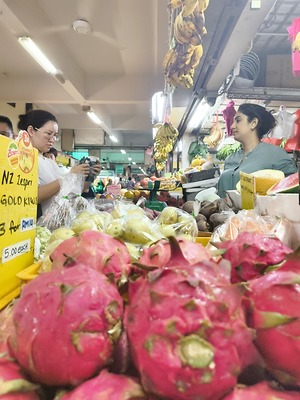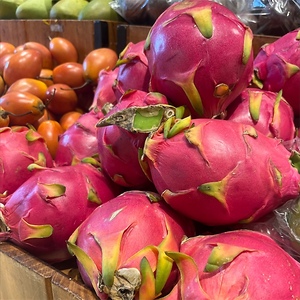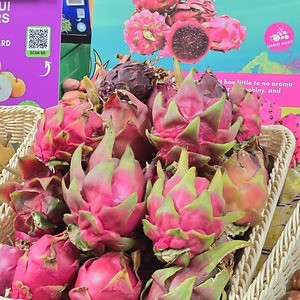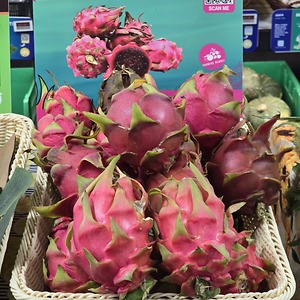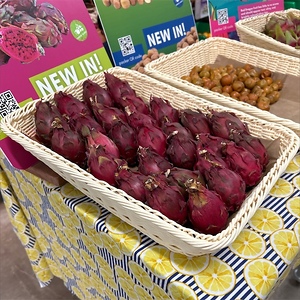

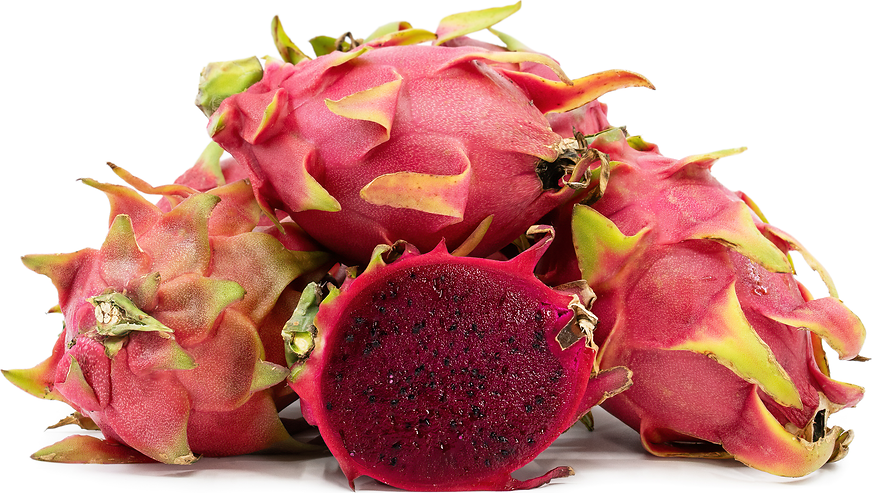
Red Pitaya Dragon Fruit
Estimated Inventory, 10 lbs : 9.30
This item was last sold on : 04/24/25
Description/Taste
Red Dragon fruits are small to medium-sized varietals, averaging 4 to 9 centimeters in diameter, and have an oval to oblong shape. The fruit’s skin ranges in color from bright pink, fuchsia, to red-brown, and is semi-smooth and waxy, covered in fleshy, overlapping scales that showcase green tips. The curvy scales have a triangular shape, and Red Dragon fruit varieties typically have narrower scales. The thin skin can be easily peeled once sliced, revealing a dark red to crimson flesh containing many tiny, black, edible seeds. The flesh has a dense, semi-firm, and tender, aqueous consistency, contrasted with the crunchy, chewy seeds, creating a texture similar to kiwi fruit. Red Dragon fruit has little to no aroma and should appear taut, shiny, and brightly colored when ripe. The flesh has a delicate, sweet, earthy, and mildly acidic flavor combined with a faint nuttiness from the seeds.
Seasons/Availability
Red Dragon fruits are available year-round.
Current Facts
Red Dragon fruits, botanically a part of the Hylocereus genus, are exotic, tropical fruits belonging to the Cactaceae family. The fruits grow on a climbing cactus that develops long branches that travel along fences, scale walls, and wrap around trellises. Dragon fruits are native to Central and South America and are also known as Red Pitahaya or Red Pitaya. There are many different varieties of Red Dragon fruits, and the red cultivars are generally considered rarer than white and yellow types. Growers favor Red Dragon fruits for their pigmented flesh, sweet taste, higher flowering rate, and a larger quantity of fruit production. The fruits are often sold at higher, luxury prices in commercial markets and are consumed fresh, incorporated into raw dishes, cooked into sauces and syrups, or blended into desserts and cocktails. Red Dragon fruits include varieties known as Red Jaina Natural Mystic, Zamorano, Costa Rican sunset, and Strawberry Pear cactus, and the fruits are commercially sold fresh, frozen, and dried.
Nutritional Value
Red Dragon fruits are a good source of vitamin C to strengthen the immune system, fiber to regulate the digestive tract, potassium to balance fluid levels within the body, and phosphorus to protect bones and teeth. The fruits also contain magnesium, iron, and are rich in betacyanins and lycopene, compounds that give the flesh its red pigment.
Applications
Red Dragon fruits have a mild, sweet, and subtly earthy flavor well suited for fresh and cooked preparations. The fruits are traditionally consumed straight out of hand, cut in half, and scooped directly from the rind with a spoon. Many prefer to refrigerate the fruits before eating, as chilling enhances the flesh’s flavor. Red Dragon fruits can also be sliced into fruit and acai bowls, tossed into salads, chopped into slaws, or combined with an acid, peppers, and spices to make a flavorful topping or side dish. Try incorporating Red Dragon fruits into pancake batter to create a rosy-hue breakfast dish. Red Dragon fruits can also be blended into smoothies or frozen into popsicles, ice cream, and sorbet. Beyond fresh preparations, Red Dragon fruits can be simmered into syrups and sauces and combined into cookies, cakes, macaroons, and other desserts. It is important to note that the red pigment in the flesh will stain skin, surfaces, and clothing, so care should be taken. In mixology, Red Dragon fruits are used as coloring, flavoring, and as an edible garnish in cocktails. The flesh can also be cubed, frozen, and dropped into champagne to infuse a pink hue. Outside of the fruit, the young flower buds can be cooked and prepared as vegetables, or the dried flowers can be steeped into herbal tea. Red Dragon fruits pair well with other fruits such as pineapples, strawberries, bananas, coconut, and blueberries, seafood including white fish, shrimp, and crab, tofu, rice, sesame, cashews, shallots, and garlic. Whole, unopened Red Dragon fruits will keep for a couple of days at room temperature and 1 to 2 weeks when stored in a plastic bag in the refrigerator. Sliced and cubed flesh can be frozen in the freezer for extended use.
Ethnic/Cultural Info
Dragon fruits received their mythical moniker when they were introduced to Asia in the 1800s. Experts believe pitayas were first brought to Southeast Asia through French missionaries and were planted in Vietnam. After their introduction, the colorful cactus fruits were spread across Southeast Asia into China, where growers began marketing pitayas as dragon fruits. These marketers also spread wild stories of how the fruits came from dragons, creating a whimsical reputation, further sparking interest in the fruits. Legend has it Red Dragon fruits are developed from the final breath of a slain dragon. The perishing dragon must use all his might for breathing his last flamed breath, and this flame originates in the dragon’s body near the base of its tail to construct the flame-like fruit. After the dragon had fallen, the fruit was presented to the Emperor as a gift and symbol of victory. The story also mentions that soldiers would eat the dragon, coveting the base of the tail as the most sacred cut of meat. This portion of the tail was known as the “jaina,” translating to mean “the sweetest and best tasting.” Dragon fruits are sometimes labeled as jaina in Asian markets as the fruit is believed to have stemmed from that portion of the dragon’s body.
Geography/History
Dragon fruits are native to Mexico and Central America and have been growing wild since ancient times. The fruits thrived in tropical, subtropical, to somewhat arid regions and were transported to the Caribbean, West Indies, and South America in the early ages. Dragon fruit was brought to Southeast Asia in the early 1800s and was initially reserved for wealthy families and nobility. Over time, the plants became commercially cultivated for widespread consumption, spreading across Asia, and were eventually introduced to the Middle East and Australia. Red Dragon fruits were also brought to Hawaii in 1830. Today Red Dragon fruits are grown worldwide in home gardens and are commercially produced in Asia, Israel, Australia, Mexico, Nicaragua, and the United States. When in season, Red Dragon fruits are available through specialty distributors, markets, and farms stands.
Featured Restaurants
Restaurants currently purchasing this product as an ingredient for their menu.
| InterContinental Banquet Kitchen | San Diego CA | 619-501-9400 |
| Mister A's Pastry | San Diego CA | 619-239-1377 |
| Stake Chophouse & Bar | Coronado CA | 619-522-0077 |
| Kinme (Deliver to Azuki) | San Diego CA | 619-238-4760 |
| The Wild Thyme Company | San Diego CA | 858-527-0226 |
| Estancia Adobe | San Diego CA | 858-550-1000 |
| Asti Ristorante | San Diego CA | 619-232-8844 |
| Pamplemousse Grill | Solana Beach CA | 858-792-9090 |
| Fort Oak | San Diego CA | 619-795-6901 |
| Kona Kai Resort and Marina | San Diego CA | 619-221-8000 |
| Kinme Omakase | San Diego CA | 619-231-0700 |
| US Grant Hotel Grill | San Diego CA | 619-232-3121 |
| Convention Center East | San Diego CA | 619-525-5832 |
| Lodge at Torrey Pines Main | San Diego CA | 858-453-4420 |
| Hotel Indigo | San Diego CA | 619-295-3172 |
| Omni Hotels | San Diego CA | 619-231-6664 |
| The Flavor Chef (Catering) | Vista CA | 619-295-3172 |
| Fox Point Farms | Encinitas CA | 619-892-0553 |
| Busy Bee Cook For Me | San Diego CA | 858-405-5372 |
| Donation 3 | San Diego | 619-295-3172 |
| San Diego Yacht Club | San Diego CA | 619-758-6334 |
| Culinary Kitchen Catering and Events | Coronado CA | 619-798-8477 |
| Berry Good Food Foundation | La Jolla CA | 619-666-1633 |
| InterContinental Vistal Kitchen | San Diego CA | 619-501-9400 |
| Lafayette Hotel - Lou Lou's | San Diego CA | 619-296-2101 |
| Cardellino | San Diego CA | 619-722-3398 |
| La Jolla Beach & Tennis Club | San Diego CA | 619-816-8319 |
| Nomade Tapas and Records | San Diego CA | 619-616-1670 |
| Coco Maya by Miss Bs - Bar | San Diego CA | 858-245-3780 |
| AKA | San Diego CA | 619-595-1450 |
| Mitch's Seafood | San Diego CA | 619-316-7314 |
| Marriott Del Mar | San Diego CA | 858-369-6029 |
| La Costa Resort & Spa Main Kitchen | Carlsbad CA | 760-930-7063 |
| Cape Rey Carlsbad, a Hilton Resort | Carlsbad CA | 760-602-0800 |
| Hilton Garden Inn - Homewood Suites San Diego | San Diego CA | 619-696-6300 |
| Wormwood | San Diego CA | 619-573-0289 |
Recipe Ideas
Recipes that include Red Pitaya Dragon Fruit. One
Podcasts



